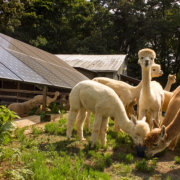Case Study: Cozy Cove Farm
By Anna Richmond-Mueller, NCAT Energy Analyst
Just outside of Gurley, Alabama, a herd of grazing llamas and alpacas find refuge from the sun underneath a solar array. Tony and Cozette O’Neil, owners of Cozy Cove Farm, have been raising the animals since 1995, shearing their fleece to make yarn and felt. Today, the O’Neils are also proud renewable energy producers for their community, thanks to the 50-kW solar system that has been generating electricity since February 2013.
A retired NASA engineer, Tony has believed in the power of solar technology since his work on the solar-powered space station Skylab in the 1970s. In 2012, with an electric bill sometimes reaching $500 a month, he learned that he could generate and sell renewable energy to the Tennessee Valley Authority (TVA). The cost of solar equipment was decreasing around this time as well, making it the ideal time to install solar on their 54-acre farm. Working with Outpost Solar, the O’Neils planned a photovoltaic system consisting of 208 fixed-tilt panels in a 100-by-100-foot area, tucked away on a corner of their pastureland next to the Flint River. Because the array was built on a floodplain, the panels had to be elevated to seven feet above ground level. The unexpected change to the design had an upside: shade for more than 100 llamas and alpacas that call Cozy Cove Farm home.
The O’Neils took advantage of several incentives to build their solar array, which totaled $160,000 upon completion. The majority of the cost was covered by a 30% federal tax credit and a 25% USDA REAP grant. Smaller grants from state and local programs brought the out-of-pocket cost to just under $48,000. Alabama Farm Credit provided the O’Neils with a loan for the remaining amount, which they were able to pay back completely in October of 2017. In just under five years, the array paid for itself thanks to a 10-year contract with the TVA that paid them 22 cents per kWh of electricity generated.
Today, 10 years after the solar system’s completion, the O’Neils continue to benefit from its installation. Service and repair costs have been low, with only one panel needing replacement from damage in the first year. At the end of their initial contract, the O’Neils signed a subsequent contract for an additional 10 years that allows the TVA to purchase the electricity they produce at the same rate their utility charges them for their energy consumption. “This provides us with approximately $3,500 a year after all of our farm energy needs are paid for,” says Tony. He also encourages other farmers considering installing solar on their property to think long-term. “Electricity cost is only going to increase in the future, and the cost of solar panels and inverters are at an all-time low at present.” While many agrisolar projects are still in the first few years of operation, Cozy Cove Farm stands as a shining example for how agrivoltaic installations can benefit their owners for over a decade.
Photo credit: Scott Sklar, George Washington University



